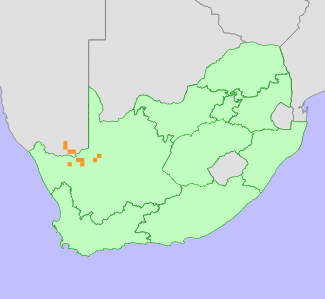|
Scientific Name | Conophytum friedrichiae (Dinter) Schwantes |
Higher Classification | Dicotyledons |
Family | AIZOACEAE |
Synonyms | Conophytum renominatum G.D.Rowley, Conophytum schwantesii G.D.Rowley, Lithops friedrichiae (Dinter) N.E.Br., Mesembryanthemum friedrichiae Dinter, Ophthalmophyllum dinteri Schwantes ex H.Jacobsen, Ophthalmophyllum friedrichiae (Dinter) Dinter & Schwantes, Ophthalmophyllum triebneri Schwantes, Ophthalmophyllum vanheerdei L.Bolus |
National Status |
Status and Criteria | Vulnerable A4d |
Assessment Date | 2021/11/23 |
Assessor(s) | A.J. Young, P.G. Desmet, I. Ebrahim, D. Guo, A. Harrower, L. Jabar, L. Knoetze, C. Rodgerson, P.C.V. Van Wyk & N.N. Mhlongo |
Justification | This succulent is endemic to the Northern Cape province of South Africa and the Karas region of Namibia with an extent of occurrence (EOO) of 30,072 km² and an area of occupancy (AOO) of 108 km². The population is in decline due to illegal collection for the international trade in ornamental succulents since 2019. Illegal collection is likely to increase as there has been a dramatic increase in the number of species and volume of plants targeted since 2019 including many from the immediate area. The threat of illegal collection is therefore regarded as very high for this particular species. This succulent has a cryptic semi-subterranean habit and occurs as individuals or small colonies scattered across broad expanses of the landscape, mainly in remote areas. Together this may restrict poaching and the future threat of illegal collection is therefore regarded as moderate for this particular species and a decline of up to 35% of the population is deemed likely within the next three generations (90 years) as a result of this activity. It therefore qualifies as Vulnerable under criterion A4. |
Distribution |
Endemism | Not endemic to South Africa |
Provincial distribution | Northern Cape |
Range | This species is only known from the Karas region of southern Namibia and the Northern Cape province of South Africa. |
Habitat and Ecology |
Major system | Terrestrial |
Major habitats | Nama Karoo, Succulent Karoo |
Description | This dwarf succulent inhabits patches of quartz stones in the Succulent Karoo and Nama-Karoo biomes (Richtersveld and Bushmanland & West Griqualand bioregions, respectively). Out of flower the plants can be very cryptic as most of the plant is usually submerged beneath the stones. This species has a generation length of 30 years. It is expected to be sensitive to the impacts of climate change as it does not disperse and while adapted to arid conditions, is dependent on limited seasonal rainfall. Species in the genus are sensitive to long periods of drought. Drought related mortality has been observed for other closely related taxa within the genus. |
Threats |
| This species is currently threatened by illegal collection for the international trade in ornamental succulents. This is likely to increase in future as there has been a dramatic increase in the number of species and volume of plants targeted since 2019.
There is no decline in habitat quality for this species as inferred by changes in vegetation cover determined from changes in Enhanced Vegetation Index (EVI) between 1984 and 2018 using Landsat data (Venter et al. 2020). Anthropogenic climate change is a long-term threat to this species. Climate models for the likely emission scenarios where emissions stay at present day levels (RCP 2.6) (Hausfather and Peters 2020) and worst case scenarios where emissions continue to increase during the 21st century (RCP 8.5) indicate that there will be a loss of suitable bioclimatic envelope of between 23% and 46% by 2080 for this species. However, as this taxon possesses certain traits likely to afford resilience to xerophytic conditions it is expected to have a level of resilience to climate change and the expected population loss is reduced by 20% to negligible levels. Species in this genus have limited dispersal ability and migration to suitable habitats elsewhere is regarded as highly unlikely. |
Population |
The wide distribution and scattered nature of the plants across wide areas coupled with their cryptic, semi-subterranean habit has meant that there are no formal estimates of population size for this species. The number of mature individuals is likely to be well in excess of 25,000. The number of plants in this general area have been in decline in recent years due to an extended drought and the population may be in decline.
|
Population trend | Decreasing |
Assessment History |
Taxon assessed |
Status and Criteria |
Citation/Red List version | | Conophytum friedrichiae (Dinter) Schwantes | Least Concern | Raimondo et al. (2009) | | Conophytum friedrichiae (Dinter) Schwantes | Not Threatened | Hilton-Taylor (1996) | | Ophthalmophyllum vanheerdei L.Bolus | Uncertain | Hall et al. (1980) | |
Bibliography |
Hammer, S. 2002. Dumpling and his wife: New view of the genus Conophytum. EAE Creative Colour, Norwich.
Hammer, S.A. 1993. The genus Conophytum: A conograph. Succulent Plant Publications, Pretoria.
Hausfather, Z. and Peters, G.P. 2020. Emissions - the 'business as usual' story is misleading. Nature 577(618-620).
Opel, M.R. 2004. The rediscovery of Crassula alcicornis. Haseltonia 10:38-40.
|
Citation |
| Young, A.J., Desmet, P.G., Ebrahim, I., Guo, D., Harrower, A., Jabar, L., Knoetze, L., Rodgerson, C., Van Wyk, P.C.V. & Mhlongo, N.N. 2021. Conophytum friedrichiae (Dinter) Schwantes. National Assessment: Red List of South African Plants version 2024.1. Accessed on 2025/10/19 |
 Comment on this assessment
Comment on this assessment


